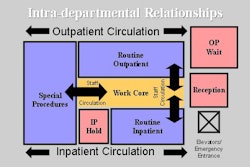
By Elsa Ozuna-Richards
REA Healthcare Strategies

Unfortunately, increasing awareness, or even printing customer-service standards in every employee training manual, won't create a workforce that's finely tuned to providing flawless service. So how do we ensure that our patients receive the full "Nordstrom’s customer treatment" in our medical offices?
Nordstrom began as a family-owned shoe store in Seattle in 1901, added fashion and apparel in the 1960s, and went public in 1971. Today, its 59 full-line and 17 clearance stores in 12 states are known as much for customer service as they are for merchandise. Major tenets of the retailer’s customer-service philosophy are to value good service from its employees, find and bond with customers, serve and keep those customers, and give front-line employees the freedom to make decisions.
The purpose of the medical practice is to provide the highest level of attentiveness to ill people. Think of the good service one might receive when buying a new purse at Nordstrom. So before a practice implements a customer-service program that would cause even Nordstrom to take notice, it's important to take a critical look at operations, and identify key issues that might be obstructing the staff’s ability to provide award-winning care.
Key components set the foundation
A good customer-service model runs best when implemented from the top down. The practice’s owners and management team must champion this program by example. Truly, they must be the individuals who will carry the service torch at all times. Simply insisting that employees begin treating every client with kid gloves, or documenting service standards in an employee publication, won't create the practice culture needed to become the Nordstrom’s of medicine.
Second, workflow must be evaluated throughout the practice in search of roadblocks that decrease the ability of the employee to properly care for patients' needs. Employees must also have the proper tools to effectively carry out tasks, such as formalized policies, procedure manuals, and office equipment that functions properly.
Finally, proper training for each position is essential. Investing time in employee training can be the key to successful performance. The combination of these factors helps create the environment conducive to extending the red carpet treatment for the practice’s clients.
Top-down brings them all around
We lead by example. Management sets the tone for great customer service. First, by treating the staff with respect and courtesy we define a friendly standard and establish the culture for a specified pattern of behavior. When you walk through your department, smile and greet your patients and co-workers. Stop at the reception desk or technologist’s work area and ask how things are going. Take a minute to help if things are going awry. Make small talk if there's an opportunity to chat. Help a patient find a magazine or open the door for someone. Allow your staff to see your commitment to service.
Most critically, return patient phone calls, especially if a patient feels that he or she received less than optimal care. Talk to your clients and hold your management team responsible for doing the same. The staff will respect your attentiveness to them, recognize their contribution to your practice, and see the concern that you demonstrate for your patients. Most important, what you learn can help you refine any glitches in your workflow model.
Is workflow an issue?
Performing a workflow analysis is important to clearly understand how efficiently the work flows in your department. As managers, we know that we rarely have to move past our reception desk to identify some service hang-ups.
In many practices, for example, receptionists are hired with entry-level skills for a job profile that is extremely complex. These individuals must be accurate, thorough, have good communication skills, typing skills, be able to multitask, and have the ability to retain a lot of information. And these are just some of the basics.
They must also be experts with healthcare insurance, understand and remember the co-pays for every insurance carrier in the U.S., understand medical terminology, know how to look at medical records and extract detailed information for patient registration, know about examination preps, understand every language that comes in the door, handle multiple charts on their desk, and know every idiosyncrasy of every physician on staff, as well as every physician who calls in.
How many other positions in our departments fit this profile? We can first start by evaluating the tasks that are performed by the receptionist. Establish which tasks truly need to be performed at the receptionist desk and then assign the remaining duties to other employees who are more experienced and can easily perform those tasks. This exercise can create a more customer-friendly receptionist.
Since employees also tend to personalize the manner in which they perform their job duties, there is potential to create redundant or inefficient processes of which the management team is not aware. During one of my workflow appraisals, I found one Medicare collector copying every single explanation of benefits (EOB) that came through her desk. Since we would microfiche everything, it surprised me that she was doing this. My greatest concern was that the copying was taking one and a half hours of her day.
When asked why she was doing this, she responded, "I need to have all of the paperwork near me." This individual had allowed certain negative interactions with Medicare personnel to alter her workflow. We were behind on Medicare collections and phone calls were not being returned promptly. We eliminated the copying process from her daily chores. She began to document only key pieces of information on the billing system. As a result of the changes, she was able to spend more time collecting and addressing billing questions from our patients.
If resources are tight for a workflow analysis, the management team can have each member in their department list their job tasks. Each task should be designated if performed daily, weekly, or monthly. Each task should have the time required to perform the task, as well as volumes of work being done in the specified time period. Although all of our departments would benefit from this analysis, streamlining workflow would immediately benefit accounts receivable (A/R), scheduling, and reception desks that are encumbered with a lot of processing.
Supply the necessary tools
Formalize guidelines for employees to follow during the course of interactions with clients. In many hurried situations, our staff members need a quick reference, which speeds their ability to respond to a client’s need.
For example, a receptionist can benefit from having a quick reference to the various insurance cards that you accept. Highlight key information on the card so that the receptionist can quickly glean the necessary information.
Schedulers can benefit from an easy-to-follow scheduling manual. Identify each exam, contraindications to the exam, prep, exam times, and manpower resources necessary (radiologist or nurse). Most information systems offer these features. If not, a compact, easy-to-read scheduling manual will boost your customer-service skills at scheduling.
Make sure the fax machine, computer, and printers all work. These accessories are critical to providing good customer service.
Train, train, train
Establish a well-defined employee training program. We are always anxious to get an individual into a job and may sacrifice proper training. Establish a training program that gives the individual a perspective of overall operations, and then train them specifically for their job. This gives the new employee a well-rounded perspective of your operations and better prepares them for the department for which they were hired.
For example, a scheduler benefits from watching exams; a receptionist understands insurance better when trained for a short period of time in the A/R department; and a technologist acquires a different perspective about scheduling for their department when they can spend time in scheduling.
As new programs are unveiled, train the staff for each new service. They will be the ambassadors for growing the business, and everything that they learn will contribute to the success of a new program. We all experience the limitations of budgets; therefore, as individuals attend outside training sessions, they should hold a recap meeting for other staff members that were not able to attend. Schedule these within a month of the initial training so that material is fresh.
Utilize staff for training whenever possible. For example: hold lunch training meetings for the reception and scheduling staff. Technical staff can take turns in presenting material to increase the scope of their knowledge about procedures performed. These sessions will ultimately elevate the standard of customer care provided by the clerical staff.
You too can have impeccable customer care
Strive to learn, teach, and establish standards by example. By giving respect and extending courtesy, you will gain respect and foster an "I can do that, too" attitude. It won’t be long before clients and patients notice the difference in your service compared to the competition. Most important, you’ll be extending the red carpet treatment to those who could really use it!
By Elsa Ozuna-Richards
AuntMinnie.com contributing writer
November 22, 2002
REA Healthcare Strategies is a consulting firm focusing on healthcare marketing and practice management. It specializes in developing marketing programs for practices and vendors. It also has extensive experience in providing medical practices with strategic planning, project management, and customer-service training programs.
Related Reading
Medical conferences bring market muscle to imaging center technology, November 5, 2002
Building a successful new imaging center program, October 8, 2002
Clinical IS audits tune performance, productivity, October 3, 2002
Imaging center marketing: Don't trade dollars for doughnuts, September 18, 2002
Performance metrics can help maximize investment returns, July 29, 2002
Copyright © 2002 REA Healthcare Strategies



















